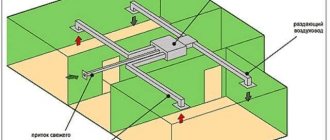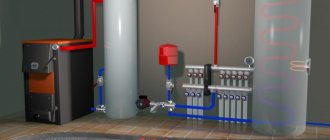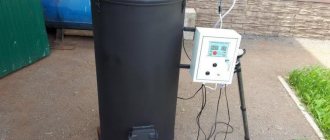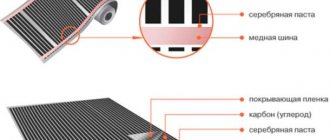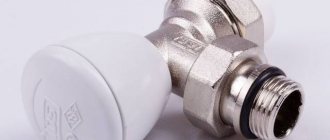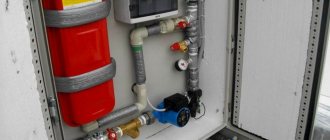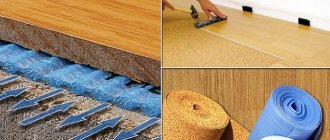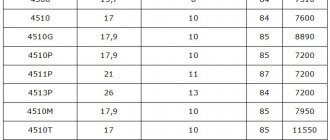What should good ventilation be like?
Construction requirements and standards clearly regulate what ventilation should be like in the sanitary rooms of an apartment or private house where there is a high level of humidity.
The ventilation system for a separate bathroom and toilet should supply a fresh air supply of 25 cubic meters. m/h. Whereas for a combined room this figure increases to 50 cubic meters. m/h.
Only a sufficient supply of fresh air and uniform removal of waste air will reduce the risk of diseases caused by musty air. And this is doubly pleasant, since such diseases often take on a chronic form. Plus, the risk of condensation, mildew and mold is minimized.
Calculation of exhaust ventilation - all formulas and examples
Proper ventilation in the home significantly improves a person’s quality of life. If the supply and exhaust ventilation is incorrectly calculated, a lot of problems arise - for a person with health, for a building with destruction.
Before starting construction, it is mandatory and necessary to make calculations and, accordingly, apply them in the project.
Physical components of calculations
According to the method of operation, ventilation circuits are currently divided into:
- Exhaust. To remove used air.
- Inlet. To let in clean air.
- Recuperative. Supply and exhaust. Remove the used one and bring in a clean one.
In the modern world, ventilation schemes include various additional equipment:
- Devices for heating or cooling supplied air.
- Filters for purifying odors and impurities.
- Devices for humidification and air distribution throughout rooms.
When calculating ventilation, the following values are taken into account:
- Air consumption in cubic meters/hour.
- Pressure in air channels in atmospheres.
- Heater power in kW.
- Cross-sectional area of air channels in sq. cm.
Calculation of exhaust ventilation example
Before starting the calculation of exhaust ventilation, it is necessary to study the SN and P (System of Norms and Rules) design of ventilation systems. According to SN and P, the amount of air required for one person depends on his activity.
Low activity – 20 cubic meters/hour. Average – 40 kb.m./hour. High – 60 kb.m./h. Next, we take into account the number of people and the volume of the room.
In addition, you need to know the frequency - a complete exchange of air within an hour. For a bedroom it is equal to one, for living rooms - 2, for kitchens, bathrooms and utility rooms - 3.
For example, calculate the exhaust ventilation of a room of 20 sq.m.
Let's say two people live in a house, then:
V (volume) of the room is equal to: SxH, where H is the height of the room (standard 2.5 meters).
V = S x H = 20 x 2.5 = 50 cubic meters.
Next V x 2 (multiplicity) = 100 kb.m./h. Otherwise – 40 kb.m./h. (average activity) x 2 (persons) = 80 cubic meters/hour. Choose a higher value – 100 kb.m./h.
In the same order, we calculate the exhaust ventilation performance of the entire house.
Calculation of exhaust ventilation for industrial premises
When calculating the exhaust ventilation of a production room, the multiplicity is 3.
Example: garage 6 x 4 x 2.5 = 60 cubic meters. 2 people work.
High activity – 60 cubic meters/hour x 2 = 120 cubic meters/hour.
V – 60 cubic meters x 3 (multiplicity) = 180 kb.m./h.
We choose a larger one - 180 cubic meters / hour.
As a rule, unified ventilation systems are divided into:
- 100 – 500 cubic meters/hour. - apartments.
- 1000 – 2000 cubic meters/hour. – for houses and estates.
- 1000 – 10000 cubic meters/hour. – for factory and industrial facilities.
AIR HEATER
In the middle climate, the air entering the room must be heated. To do this, supply ventilation is installed with heating of the incoming air.
Heating of the coolant is carried out in various ways - with an electric heater, the intake of air masses near radiator or stove heating. According to SN and P, the temperature of the incoming air must be at least 18 degrees. Celsius.
Accordingly, the power of the air heater is calculated depending on the lowest (in a given region) street temperature. Formula for calculating the maximum heating temperature of a room with an air heater:
N/V x 2.98 where 2.98 is a constant.
Example: air flow – 180 cubic meters/hour. (garage). N = 2 kW.
Further 2000 W / 180 kb.m./h. x 2.98 = 33 deg.c.
Thus, the garage can be heated to 18 degrees. At outside temperature minus 15 degrees.
Pressure and section
The pressure and, accordingly, the speed of movement of air masses is affected by the cross-sectional area of the channels, as well as their configuration, the power of the electric fan and the number of transitions.
When calculating the diameter of the channels, the following values are empirically taken:
- For residential premises – 5.5 sq.cm. per 1 sq.m. area.
- For a garage and other industrial premises - 17.5 sq.cm. per 1 sq.m.
In this case, a flow speed of 2.4 – 4.2 m/sec is achieved.
About power consumption
Electricity consumption directly depends on the duration of operation of the electric heater, and time is a function of the ambient temperature. Usually, the air needs to be heated in the cold season, sometimes in the summer on cool nights. The formula used for calculation is:
S = (T1 x L x d x c x 16 + T2 x L x c x n x x N/1000
N/1000
In this formula:
S – amount of electricity.
Т1 – maximum daytime temperature.
T2 – minimum night temperature.
L – productivity cubic meters/hour.
c – volumetric heat capacity of air – 0.336 W x hour / kb.m. / deg.c. The parameter depends on pressure, humidity and air temperature.
d – price of electricity during the day.
n – price of electricity at night.
N – number of days in a month.
Thus, if you adhere to sanitary standards, the cost of ventilation increases significantly, but the comfort of residents improves. Therefore, when installing a ventilation system, it is advisable to find a compromise between price and quality.
Source: https://vent-vozduh.ru/kak-rasschitat/raschet-vytyazhnoj-ventilyatsii.html
Calculation of optimal performance
Any room is characterized by a multiplicity - the number of times during which the air must be completely renewed in a certain period of time. For the bathroom this is 10 times per hour. To determine the optimal performance of the hood, you need to know the volume of the room. The area of the bathroom is multiplied by the height. This will be the minimum multiplicity.
The power of the ventilation system depends on the size of the bathroom
If it is not possible to organize a fan in the place required for work, its power must be increased several times.
How to calculate a ventilation system
Let's imagine that you decide to build a house: the foundation, the walls, the layout of the rooms - everything is as it should be. But what about the ventilation system? How to lay and which one to choose to ensure maximum comfort in a new home?
There is a fairly simple method, thanks to which you can select the main elements of the supply ventilation system , as well as calculate the natural and exhaust ventilation system for your home.
Let's start with the fact that when choosing the necessary equipment for a supply ventilation system, it is necessary to be guided by certain parameters: air capacity, the main operating pressure that the fan creates, the cross-sectional area of the air vents, air flow speed and the maximum permissible noise level limit.
In order to determine the required performance, you need to calculate two main indicators of air exchange: by the number of people in the room and by the so-called multiplicity.
After this, make a choice in favor of the larger of these two indicators. 1. By multiplicity, the calculation of air exchange is implemented as follows:
L = n * S * H ,
where L is the required productivity of supply-type ventilation, m3/h;
n - standardized air exchange rate: for residential premises n = 1, for office premises n = 2.5;
S—area of a specific room, m2;
H—height of the concrete room, m;
2. And the indicator for calculating air exchange by the number of people is thus:
L = N * Lnorm, where L is the required productivity of supply-type ventilation, m3/h; N is the number of people; Lnorm - standard air flow per person: at rest the norm is 21 m3/h; when working in an office, the standard is 41 m3/h, and for intense physical activity - 59 m3/h. Also, use typical performance indicators of ventilation systems. For apartments, productivity ranges from 110 to 490 m3/h, for cottages it ranges from 999 to 1990 m3/h; and for offices - from 999 to 9999 m3/h. At the same time, when you calculate the various heater powers, you must take into account the limitations: if the heater power is more than 4 kW, a three-phase connection is required.
3. The maximum permissible current consumed by the heater can be calculated using a certain formula:
I=P/U,
Where I is the largest current used, A;
P — heater power, W;
U - supply voltage:
220 V - indicator for single-phase power supply;
660 V (220 V) - for three-phase power supply.
4. In those rare cases when the possible load on the electrical network is less than necessary, you can install a heater with reduced power. The heating temperature of the supply air heater is displayed as follows:
T=2.98*P/L,
Where T is the temperature difference between the supply and incoming air of the supply ventilation system, °C;
P — heater power, W;
L is the productivity of the ventilation system, m3/h.
Traditional values for the calculated heater power range from 2 to 6 kW for apartments, from 4 to 51 kW for office premises.
If it is not possible to use a heater with the required design power, it is recommended to install a heater, which is usually used as a heat source.
The pressure required for operation is determined using the technical characteristics of the fan , based on the diameter, type of air, number of transitions and turns from one diametric size to another, type of air distributors. The longer the track itself and the more turns and transitions it includes, the correspondingly greater should be the pressure created by the fan. The air flow speed also depends on the diameter of the air ducts themselves. As a rule, this indicator is limited to a value from 1.5 to 4.5 m/s. And at higher speeds, pressure losses increase and noise levels increase.
But, unfortunately, it is not always possible to use “quiet” air ducts of the required diameter, due to the difficulty of placement in the inter-ceiling cavity. Therefore, when designing a ventilation system, a compromise is chosen between the diameter of the air ducts, the required fan performance and the most acceptable noise level. For household supply-type ventilation systems, air ducts with a cross-section of 150-260 mm and special distribution grilles with a cross-section of 210-330 mm are most often used.
Classification of exhaust fans
According to the method of installation of the device there are:
- ceiling ones , which are attached to the ceiling. Recommended for use in large rooms where large air circulation needs to be handled;
- wall- mounted They are mounted on the wall in the hole leading to the air duct. The most common.
Externally, the fans are not very different from each other, but the decorative trims can be different.
According to the internal structure:
- axial : high performance, but too noisy;
- radial : easily tolerate air loads and operate quietly;
- centrifugal : have high power; low noise level; used for rooms over 15 square meters. m; installed on the ceiling;
- roof : mounted on the roofs of multi-storey buildings; powerful; work quietly; allow you to connect many living spaces to the ventilation system.
How to calculate fan power
For installation in the kitchen, axial structures are most often used. They are capable of developing quite high productivity, but their pressure is low and is not able to overcome the resistance of the air ducts. To work with an extensive network of channels, radial structures are used that are capable of creating sufficiently high pressure and overcoming the resistance of the network. At the same time, household fans have a predominantly axial design
.
The performance of a specific fan is indicated in the passport or on the packaging of the device. This is the actual value, which should be 15-20% higher than the calculated one
. This is done so that there is a certain reserve of power of the device, which is necessary when air pollution increases.
The calculated productivity value is found by multiplying the volume of the kitchen by the air exchange rate. For example, if a kitchen has 8 m2 of area with a ceiling height of 2.5 m, then its volume is 20 m3. Then the calculated performance
the fan is in the range of
200-300 m3/hour
.
Accordingly, the actual
fan performance should be
from 240 to 360 m3/hour.
For bathroom
rooms,
the air exchange rate
is lower and equal to
3-8 times/hour.
In addition, the air in the bathroom contains water vapor, but there are no combustion products, oil or fat particles in the air. The volume of the bathroom is also small, so the throughput of a standard ventilation duct usually copes with its task. However, exhaust fans are installed in the bathroom to speed up the process of removing moist air and ensure that there is no mold or mildew.
Performance
is calculated in the same way -
the volume of the room is multiplied by the multiple = device performance.
Having such data, you can begin to select a device.
How to install ventilation in the bathroom
Before installing a fan in a bathroom or toilet, you need to compare its diameter with the size of the air vent. If it is smaller, corrugation is put on, and the voids are sealed with polyurethane foam. If more, just use a hammer drill.
Since the main task of ventilation is to remove hot air from the bathroom, the optimal location for installing the fan is considered to be the top of the wall opposite the door.
Before proceeding with the installation of the ventilation system, it is recommended to carefully read the instructions for it. This will get rid of many problems in the future.
Ventilation diagram for a separate bathroom in an apartment
Installation instructions:
- Remove the front cover.
- Apply liquid nails to the area where the fan meets the wall surface.
- Place the fan with its working part into the wall so that it is not visible.
- Press the body so that the glue sets.
- Install a mosquito net.
- Attach the front cover using dowels.
- Then you need to lay the cable and connect the fan.
Common installation mistakes
Often, when the installation of a ventilation system is not carried out by a specialist, problems arise after its installation. Either the system is ineffective, or... The main reason for this is improper installation of the fan.
The cover must be firmly secured so that there are no unnecessary sounds during operation.
Popular problems after installing ventilation:
- loud noise during operation;
- poor tightness of the shaft connection;
- obstruction of air movement due to poorly designed channel.
A strong hum during the operation of the ventilation system can occur if there is a misalignment. To do this, it is recommended to dismantle the unit and reinstall it. In this case, you need to re-read the instructions for use and installation of the fan again.
If you don’t want to do this, you can choose a simpler option. To do this, do not look for the cause of what happened, but solve its consequences. Install sound absorbers.
Fresh indoor air is the key to people's health. And the bathroom should be no exception. Because there are no windows in the room. Ventilation cannot be provided. The only correct solution in this case is to install a forced ventilation system. But it also needs to be calculated, the right fan must be selected and it must be installed correctly. How best to do this is described in our article.
Source
Natural or forced?
Before you make ventilation in the bathroom and toilet, carry out diagnostics. To understand whether there is enough natural draft for normal ventilation, you need to evaluate the efficiency of air exchange. It is measured with a special device - an anemometer, for which a specialist is most often called. However, you yourself may notice that the ventilation is not doing its job. The following signs indicate this:
- Condensation appears on walls and mirrors.
- Odors are difficult to dissipate.
- The air seems stale.
- Linen and towels do not dry.
- Fungus and mold form.
The ventilation status can be checked without waiting for alarms. Use the easiest way:
- Take a piece of thin paper or a napkin.
- Open the bathroom door and the window closest to it.
- Place the sheet of paper against the ventilation grill and release: the air flow should pull it towards the hole.
If the test is successful, you can do without forced ventilation in the bathroom. Please note: if you move into a new apartment during the cold season, the first impression may be deceiving. The fact is that the difference in temperatures outside and inside the room promotes air movement, so it is better to draw conclusions about the state of the system in the summer.
Organization of natural ventilation
To properly organize natural air exchange, you need to:
- Determine the direction of the air duct route depending on the layout of the room and the natural ventilation shaft. It is advisable to avoid a large number of corners and bends, and also consider the possibility of disconnecting and cleaning the channels.
- Connect the bathroom and toilet with a ventilation duct. The easiest way to do this is to use flat air ducts with a cross-section of 110×55 mm or 204×60 mm and a set of components. Depending on the configuration of the air route, it includes connectors, elbows, transitions, tees, holders and plates.
Proper forced ventilation in the bathroom
For forced ventilation in the bathroom and toilet, you need a fan that will ensure constant air circulation. Depending on the model and installation method, you can achieve different effects:
- exhaust ventilation: removes “exhaust” air from the room;
- supply ventilation: provides fresh air supply;
- supply and exhaust ventilation: performs two tasks at once, allowing you to comprehensively solve any problems with air exchange.
Usually an exhaust fan is installed in the bathroom and toilet: it removes moisture and unwanted odors from the room. Below we will tell you which bathroom fans are best and how to install them correctly.
You may find it useful
What types of kitchen hoods are there?
Before proceeding to calculate the required power of the hood, you should decide on its type. There are several varieties of these household appliances. The difference between them is not only in design, but also in the principle of operation. This can be either the removal of polluted air from the room or its recirculation after appropriate cleaning.
Dome
The polluted air, after entering the dome of such an exhaust hood, is thrown out by fans outside through a piping system.
Features of dome-type exhaust devices:
- The system requires a minimum of maintenance, but during its operation it requires an influx of fresh air into the room from outside.
- If the kitchen has modern double-glazed windows that do not allow air to pass through, then you may need to open the window while the hood is operating.
- The disadvantages of this system also include quite significant dimensions and complex installation.
- Such hoods are recommended for use in spacious rooms.
- The complex of boxes and corrugated connections must have a minimum of bends that impede the movement of air.
Flat
These hoods are more compact and easy to install. Unlike dome ones, they do not require connection to ventilation ducts, as they work on the principle of air recirculation.
Features of flat hoods:
- They don't take up much space in the kitchen.
- Require regular maintenance: carbon filters responsible for neutralizing odors will have to be changed every 3-6 months, depending on the intensity of cooking.
- Soot and grease are captured by replaceable acrylic or permanent metal filters. The former will also have to be changed regularly, and the latter washed with detergents.
USEFUL INFORMATION: Siphon for connecting a dishwasher
Built-in
It is better to buy built-in models at the stage of planning the overall kitchen interior. For them, you will have to select or specially order furniture in which most of the hood will be placed.
Features of built-in hoods:
- In their design, they are very similar to dome ones, but, as a rule, they are distinguished by greater power and lower noise levels.
- Most of their design will be hidden inside the furniture, so you won’t have to rack your brains about how to harmoniously fit such a hood into the overall composition of the kitchen.
Note! Even powerful dome and built-in hoods will not be able to provide more air exchange than the capacity of the apartment’s ventilation duct.
In most houses, ventilation ducts can provide unimpeded passage of no more than 180 m3 per hour. Therefore, it is preferable to use hoods that operate on the principle of air recirculation or mixed-type devices. Their higher cost is compensated by their independence from the ventilation capacity of the apartment. Also, there will be no need to solve the problem of fresh air entering the room.
How to choose a fan for the bathroom
Selecting an exhaust (supply and exhaust) fan according to the type of design
Fans are axial and centrifugal (radial).
- The most common type of working mechanism is axial. Household fans operating on this principle have sufficient performance (70–100 m³/h) and do a good job of regulating local air exchange. This is the best option for ventilation in the bathroom of a private house or apartment.
- Centrifugal fans have higher productivity (100–1200 m³/h) and higher pressure. They are most often used in industrial premises and systems with long ventilation ducts and flexible air ducts that create high resistance. The main disadvantage is the price, which exceeds the average cost of axial fans.
Selecting an exhaust (supply and exhaust) fan according to the type of installation
Depending on the installation method, fans are divided into overhead and duct fans.
- Overhead models are easy to install: you do not need to disassemble the ventilation. However, they may not fit into the bathroom decor and make more noise. To ensure that the sound does not test your patience, purchase a fan with a rated capacity of no more than 100 m³/h.
- Ducted units are more efficient, discreet and produce less noise because they are mounted inside the duct system. In addition, with the help of special mufflers they can be made almost silent. For bathroom ventilation in the house, models with a capacity of up to 200 m³/h are suitable.
Types of duct fans
We have already mentioned above that duct fans are divided according to their purpose into supply, exhaust and reversible (supply and exhaust). There is no point in repeating this, so next we will focus on another classification of duct fans.
Form
Another important classification feature is the shape, which is decisive in the question of how to mount a duct fan. Fans are distinguished by shape:
- Round – inserted in the middle of a round air channel. They are also suitable for flexible air ducts, which allows you to expand the geometric parameters of ventilation;
- Rectangular. They are inserted, respectively, into a rectangular air duct. This shape of the air duct allows for more efficient use of space, with maximum volume, which is why rectangular fans are in great demand in industrial areas;
Round ducts are more difficult to make than rectangular or square ones, but they require less material due to their smaller surface area, and they also take up less space. With duct fans everything is exactly the same.
Impeller design
The fan creates vacuum and air pressure mechanically using blades. The blades must rotate around the impeller axis, but their position relative to it may be different. Depending on this, duct fans are distinguished:
- Axial (axial) – spiral blades are mounted on an impeller mounted on the motor shaft. Air moves along the motor shaft. This is the most common and familiar form of table fans;
- Radial (centrifugal). They are fundamentally different from an axial fan in the carousel method of attaching the blades to the impeller, reminiscent of the paddle wheel of an old steamship. The impeller with blades is enclosed in a box, air enters axially, and air discharge occurs perpendicular to the axis of the impeller;
- Diagonal. Here the air flow is first sucked in along the axis of the impeller, and at the exit it changes its direction by 90 degrees. In terms of the shape of the conical impeller and blades, these fans are something between the axial and radial versions, which is why they are also called “mixed”;
- Tangential (diametric). Air is supplied to a drum with blades across the axis of rotation, and is released in the same way. They are used as fans only in conjunction with climate control equipment - fan coils, thermal curtains and air conditioners;
- Bladeless. These are innovative models where air is pumped by a turbine and supplied to an aerodynamic ring of a special profile. Accelerating 15 times, the air escapes from the ring in the desired direction. The appearance of these fans is very laconic, there are no moving parts (blades), which is why they are good for external placement. They have not yet established themselves as channel channels.
Other signs
There are other criteria by which duct fans differ, and which one to choose must be decided taking into account other important conditions:
- Material. The body is made of steel, plastic or composite. Impeller - made of plastic, steel, aluminum, bronze. All these materials show varying degrees of resistance to heat, moisture and open fire, which means that when choosing, you need to take into account the operating conditions of the fan;
- In terms of noise level - standard and silent (in a sound-insulated housing). For metalworking shops where there is constant noise, there is no point in choosing a silent model. But for residential premises this circumstance is of great importance;
- According to speed characteristics - one- and two-speed. The latter allow you to regulate performance, saving energy and reducing noise levels;
- Protection from moisture, dust, mechanical influences. Here you should pay attention to grilles, filters, gaskets, engine protection class and, again, materials.
How to install a fan in the bathroom
Required Tools
- Pencil
- Roulette
- Drill, hammer drill with concrete drills
- Dowels
- Connection terminals
- Three-core cable VVG with a cross section of 3×1.5
- Screwdriver set and indicator screwdriver
- Plastic transitions
Installation of a surface-mounted fan
- Select a model that matches the diameter of the ventilation duct pipe.
- Route the power cable. Place the wiring in the grooves and cover them with lining to prevent contact with water. Another solution is wiring laid in corrugated hoses.
- Remove the front panel from the fan and install it in the hole to mark the mounting points.
- Use a drill to drill mounting holes and insert dowels into them. If necessary, drill into the wall with a hammer drill.
- Place the fan housing in the hole and pull the wires through it. Secure the housing with self-tapping screws.
- Connect the power wires to the terminals and insulate the connections.
- Secure the fan cover.
You may find it useful
Duct fan installation
Installing a duct fan directly into a ventilation shaft requires experience and installation skills. If you are not confident in your abilities, we advise you to contact a specialist.
- As in the previous case, the wiring must be laid in grooves or corrugated sleeves.
- Unscrew the terminal box cover, connect the wires to the terminals, insulate the connections and return the cover to its original position.
- Plug the fan into the outlet and check that the connection is working properly.
- To understand exactly where to install ventilation in the bathroom, measure the diameter of the air duct. The fan is mounted at a distance of one diameter from the inlet or outlet. Devices that operate on inflow are placed at the beginning of the ventilation system (where air enters the apartment), and exhaust fans are placed closer to the exit to the room itself.
- Install the fan into the air duct using clamps or holders with rubber seals to secure it. Household fans do not require fastening with self-tapping screws.
- If the duct has the same shape as the fan, installation is carried out without additional parts. You just need to seal the joints and make sure the fit is tight.
- If you are installing a square fan in a rectangular duct, use a plastic pyramid adapter of the appropriate cross-section. Proper air movement will be ensured by a part whose length is equal to half the length of the fan.
- To attach a square fan to a round duct, you will need a plastic adapter from a square flange to a circle. And here the length of the transition should be no less than half the entire length of the fan.
- Make sure that all structural elements fit tightly together. Place a grill over the inlet.
Source
Basic criteria for choosing a duct fan
To choose the best duct fan for all parameters, you need to know what points to look at. So let's look at the most key selection criteria:
- Performance. It must be selected for the room in which the ventilation will be installed.
- Noise level. For residential properties, it is advisable to choose low-noise models, and for industrial ones - productive ones, since there the noise level does not play a special role.
- Flow rate. It should be between 11 m/s and 14 m/s. If it is less, the ventilation will be ineffective; if it is more, it will make a lot of noise.
- Safety. A big plus will be the presence of protection from dust, moisture and other factors. Otherwise, a short circuit or premature failure of key components may occur.
- Additional equipment. If necessary, you can purchase a check valve, devices that set the start and end times of the engine, or other accessories.
Also, when choosing this equipment, other points are taken into account:
- purpose of the premises;
- fan type (for ventilation systems with round or rectangular air ducts);
- installation method and possibilities;
- engine type (AC or EC);
- supply voltage;
- protection class.
It is extremely important to ensure the quality of the fan you are purchasing. Read the documents that this is an original product from the manufacturer, and it comes with an official guarantee.
Duct fan performance
The first and, perhaps, the most key is the performance of the duct fan. After all, the main task of any ventilation is to ensure complete air exchange. That is, it must supply the optimal amount of air so that the people in the room feel comfortable living and/or working.
Optimal indicators are determined by state building codes DBN V.2.5-67:2013. For example, you can see the recommended air exchange for residential premises in the table below.
Table X.4 - Minimum specific ventilation air flow rates for residential buildings
| Microclimate conditions | Air exchange* | Living and sleeping rooms, outdoor air flow | Exhaust air flow, dm³/s | ||||
| dm³/(s*m²) | h -1 | dm³/(s*person)** | dm³/(s*m²) | Kitchen | Bathroom | Toilet | |
| Increased optimal | 0,49 | 0,7 | 10 | 1,4 | 28 | 20 | 14 |
| Optimal | 0,42 | 0,6 | 7 | 1,0 | 20 | 15 | 10 |
| Acceptable | 0,35 | 0,5 | 4 | 0,6 | 14 | 10 | 7 |
* - Specific ventilation air flow rates, provided in units of measurement [dm³/(s*m²)] and [h -1], correspond to each other at a ceiling height of 2.5 m.
** - The number of residents at the place of residence can be calculated by the number of beds.
Taking into account these standards, as well as the volume of the premises, the optimal productivity of the duct fan is calculated. The formula is extremely simple:
L = V x K,
Where:
- L – performance that a duct fan should have;
- V is the volume of the room (the area of the room is multiplied by its height);
- K – air exchange rate (taken from the second column).
Using simple calculations, we determine the optimal performance and select a duct fan with the same or slightly higher value (with a margin).
Duct fan noise level
Particular attention should be paid to acoustic characteristics. That is, the fan noise level. According to the standards, the optimal indicator for residential premises is 30 dB during the day and 20 dB at night. In principle, this is equivalent to a quiet whisper and is an acceptable value.
But in practice, many fans operate at a level of 30-35 dB. And even from a distance of several meters they can be annoying. Especially if there is a bedroom or children's room next to the bathroom or toilet where ventilation is installed.
To be honest, models with a noise level of no more than 25 dB are considered silent (without compromises or marketing gimmicks). And the best fans, considered leaders in this regard, emit no more than 20-22 dB.
This difference may seem insignificant to you. But after a couple of years of operation it will become huge. After all, over the years, the anti-noise pads wear out, the bearings wear out, and the air channels become clogged with dust. And then the noiselessness of the duct fan will become an extremely important characteristic.
Special engineering solutions also help to achieve a minimum sound level:
- high-precision bearings (eliminate runout and vibration);
- high-tech blades (the optimal number of blades with the required angles of inclination is selected, the impeller elements are balanced);
- technological cases made of high-quality metal and plastic (eliminate vibration of individual elements and aerodynamic noise);
- vibration-damping pads (prevent contact between the housing and the electric motor mounting points).
So even if you choose the standard model, you can still achieve maximum noise reduction. It is enough just to implement all these solutions simultaneously in a complex.
Air exchange rate and volume
The efficiency of the ventilation system directly depends on the air flow speed. The optimal value is from 11 m/s. But too high an indicator is also not needed: it should not exceed 14 m/s, otherwise the fan will become very noisy. If the speed is below 11 m/s, the ventilation will work ineffectively.
The volume of air exchange is no less important. How comfortable it will be to be in the room directly depends on it. To calculate this parameter, simply divide the fan power by the volume of the room.
Duct fan type
Today, different types of duct fans are available on the ventilation systems market:
- centrifugal;
- axial.
Each of them has its own pros and cons that you need to know about.
Axial duct fans direct the air flow along the axis of the electric motor on which the impeller is located. This is the key feature of models of this type.
Their other features:
- low productivity;
- economical electric motor;
- simple design.
Due to this, axial fans operate quietly even without additional engineering solutions. And they are inexpensive, which makes them an excellent option for household needs.
Disadvantages include modest performance. However, for small apartments and private houses it is quite enough.
Centrifugal duct fans are considered the most efficient models. But this is also their disadvantage, since such equipment can be installed in rooms with an area of 15 square meters, no less.
Also, due to their design features, centrifugal fans are the quietest. Even despite their high performance.
Another feature is the possibility of installation in the ventilation shaft of an apartment. This will create effective ventilation without damaging the interior of the room.
And most importantly: since the fans are hidden in the shaft, they are less exposed to dust and moisture. And, accordingly, they break less often and last longer.
Pipe diameter
Also, when choosing a duct fan, you need to take into account the diameter of the pipe. After all, this parameter has a very strong spread - from 79 mm to 710 mm. And the method and location of installation of the ventilation system directly depends on it.
Protection class
Special attention should be paid to the protection class. After all, the safety of ventilation equipment depends on it, as well as how long and stably it will work.
There are quite a lot of protection classes:
- IP44;
- IP45;
- IP54;
- IP55;
- IPX2;
- IPX4.
The higher the number, the better, this is understandable. But at the same time, each of them has its own decoding.
The first digit shows the level of protection from foreign objects, as well as from touching live parts:
- X – open design (no protection);
- 4 – protects against touching live parts with fingers/tools and prevents objects with a diameter of more than 1 mm (i.e. sand) from entering the housing;
- 5 – completely protects against touching live parts with anything and prevents the accumulation of dust (it penetrates into the housing, but in small quantities, which does not affect the operation of the fan in any way).
The second number shows protection from water:
- 2 – protects against drops that fall at an angle of up to 15°;
- 4 – protects against water splashes from any direction;
- 5 – protects against water jets directed at the equipment.
So, based on this information, you can easily determine that IP55 provides the best protection. But such models cost accordingly.
However, here you need to choose not the most maximum protection, but the optimal one - based on the conditions where the ventilation system will be used. For example, if you know for sure that no one will put their fingers into the device’s body, you can take a model with an open design, without protection.
Mains power
The next important selection criterion is mains power. There are also several options to choose from:
- 12 V;
- 120 V;
- 220 V;
- 380 V.
In this case, you just need to make sure that the selected ventilation will work in your home, office or business. For example, the most powerful models are connected to a 380 V network. These are usually installed in industrial enterprises. And for residential buildings (apartments and houses) they choose duct fans that operate with voltages up to 220 V.

